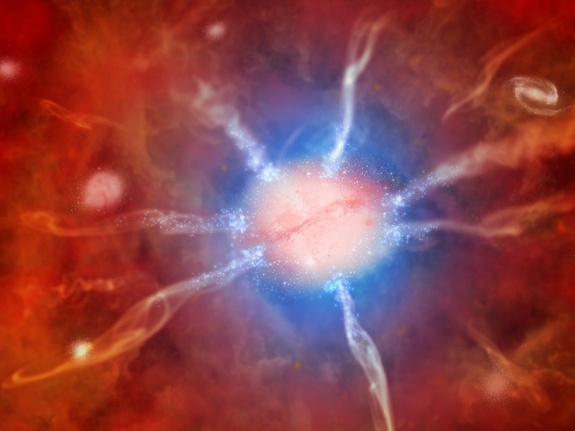While thousands of freshmen participated in “Discover McGill” as part of orientation last month, the McGill Physics Department took part in some exciting new discoveries of their own.
5.7 billion light years from our humble speck in the cosmos is a galaxy cluster 2.5 million billion times more massive than the sun; a band of galaxies held together by gravity, comprised collectively of over three trillion stars.
Dr. Gil Holder is an assistant professor in the McGill Physics department, worked on brainstorming the algorithms that professors and post-doctorates at McGill use for finding these colossal bodies.
“What I find most amazing is that this enormous object—1,000 times heavier than the entire Milky Way, emitting more X-rays than any other galaxy cluster in the universe, with a black hole at its center that is ten billion times the mass of our sun—has been only discovered now,” he said.
Compared to our Milky Way’s modest star birth-rate of one or two per year, the central galaxy of the appropriately-named Phoenix Cluster forms about 750 new stars per annum—a massive rate, never before seen in our observable slice of the universe. Researchers believe this unprecedented prolificacy can be attributed to unique properties of the supermassive black hole that lies at the centre of it all.
Under typical cosmological conditions, a black hole sucks in surrounding bodies, emitting powerful X-rays and hot energy as a result. This pumps large amounts of energy into the galaxy system, preventing surrounding gas from cooling down to form stars.
“As things fall into black holes, they are accelerated to high speeds and as they run into other things falling, they heat up and irradiate the region around the black hole,” Holder said. The Perseus Cluster is an example of this, as it has been known to periodically produce very low, powerful sound waves that disrupt the process of star formation.
“But we now have a case of a galaxy cluster that has a supermassive black hole, that somehow has managed to not act as a little furnace at the center. This is like the old classic case of ‘the curious incident of the dog in the night-time:’ we have a black hole that is not doing what is expected, and [is] believed to be natural, which must be an important clue for how these things work.”
The Phoenix Cluster may be a unique glimpse into the early stages of a galaxy cluster in which the central black hole has yet to begin its energy feedback, accounting for the brief spurt of star growth observable today.
The cluster was first discovered by NASA’s Chandra Observatory, whose satellite X-ray images have been able to depict numerous supermassive black holes as they pull in and heat material to high temperatures. As photons pass through the galaxy cluster, they are heated or cooled to temperatures that differ from the cosmic microwave background of 2.73 Kelvins—the uniform temperature of most parts of the universe, established in the remnants of the Big Bang. Large deviations from the background temperature are picked up by facilities like the Chandra, providing clues as to the location of these gas clusters.
The South Pole Telescope, to which McGill University has contributory ties, further measures microwaves of light at the millimeter-wavelength level to detect these same kinds of gas. The location of the South Pole Telescope provides a dry environment that is conducive to microwave detection. In wetter climates, atmospheric moisture absorbs certain wavelengths, like water being heated up in a microwave.
With the astronomy community still abuzz over its discovery, the Phoenix Cluster appears to be just the tip of the astronomical iceberg. Holder said, “It wasn’t in hiding or anything, we just hadn’t noticed it. For me, this really drives home that we have really just started exploring our universe, and you can never tell what you will find out there if you look carefully.”








